Affiliate links on Android Authority may earn us a commission. Learn more.
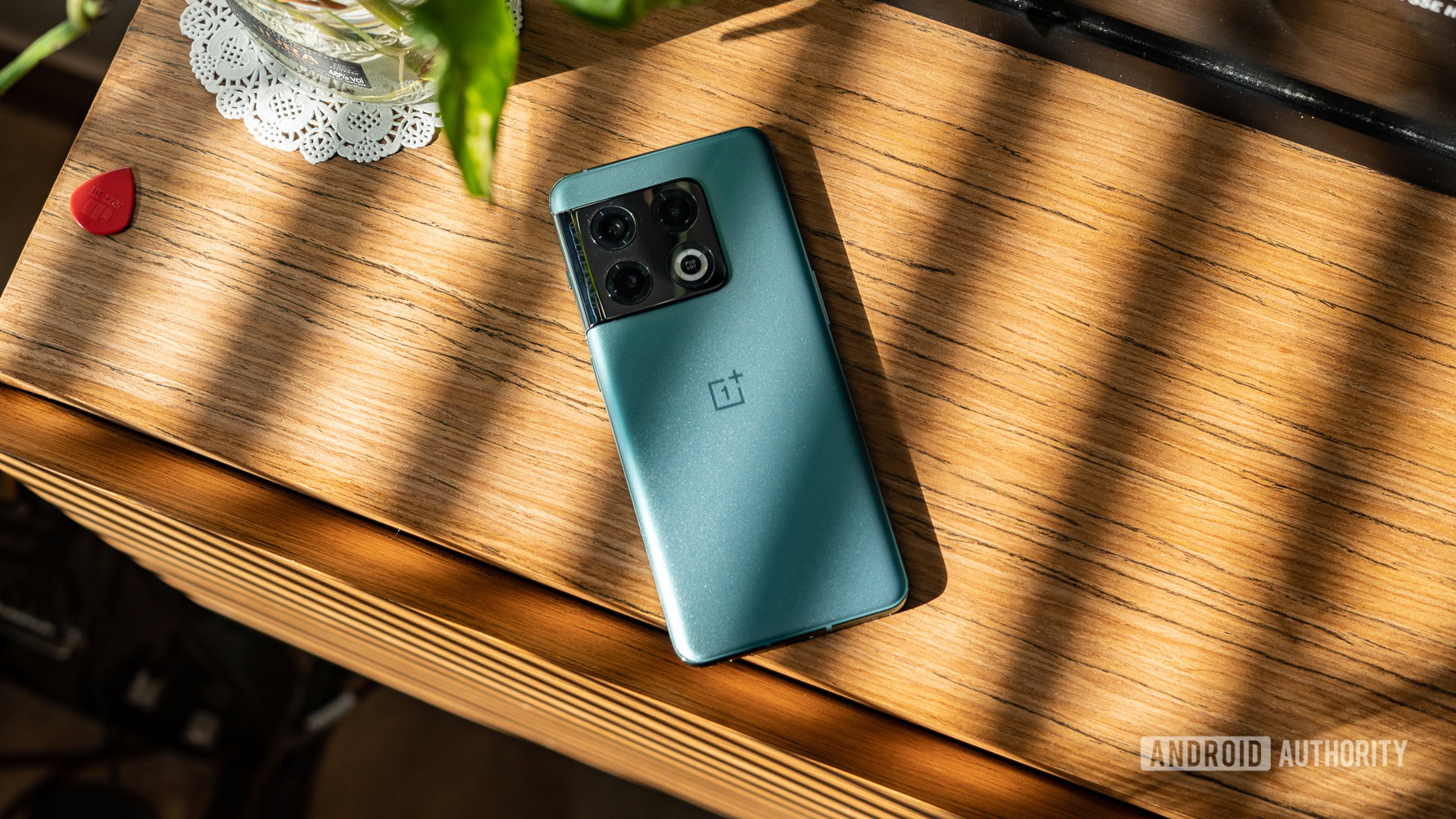
OnePlus 10 Pro
What we like
What we don't like
Our scores
OnePlus 10 Pro
The OnePlus 10 Pro is the Shenzhen-based company’s 2022 flagship Android phone, and the first to be born amidst the deepening relationship between OPPO and OnePlus. The device brings a new design to the table and some interesting camera features, backed with a top-of-the-line spec sheet to woo performance enthusiasts looking for value.
With a price cut over the previous year, the OnePlus 10 Pro sees the brand taking a modest step back towards the affordable flagship space, but still remains perilously close to the premium tier. The landscape, however, has changed a lot in the last few years, and OnePlus is far from the only option in the segment. Can OnePlus succeed in winning over a new generation of budget-minded thrill-seekers? Find out in the Android Authority OnePlus 10 Pro review.
Update, May 2023: We’ve updated this review with information relating to new competition and alternatives.
What you need to know about the OnePlus 10 Pro
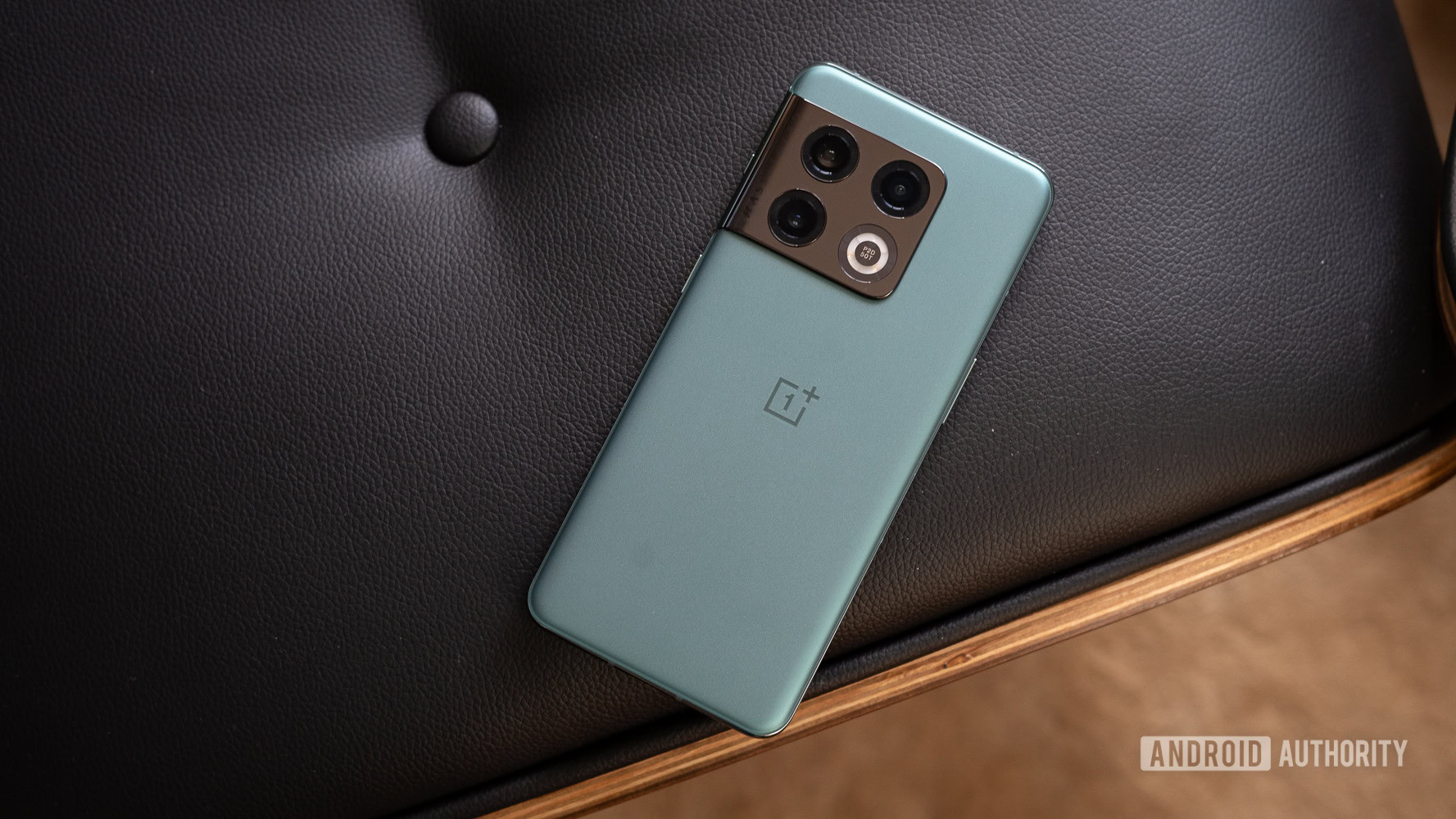
- OnePlus 10 Pro (8GB/128GB): $899 / £799 / €899 / Rs. 66,999
- OnePlus 10 Pro (12GB/256GB): $969 / £899/ €999 / Rs. 71,999
The OnePlus 10 Pro marks the first flagship launch from a team working under the united banner of OnePlus and OPPO. However, you won’t be seeing much of OPPO in the design language — it has its own unique style that differs greatly from the flagship phones we’ve seen from its BBK sister company.
Like every year, OnePlus has left no stone unturned to give it a power-packed spec sheet. The key tenets of OnePlus hardware are all here with a top-of-the-line Snapdragon 8 Gen 1 chipset, a healthy amount of RAM, and most importantly, blazing-fast charging speeds.
The phone is shipping in two variants that offer a combination of 8GB of RAM and 128GB of storage or 12GB of RAM and 256GB of storage. Buyers also get a choice of two colors: Volcanic Black or Emerald Forest.
However, the phone is competing against very strong options from Samsung, Google, and Apple, among others. OnePlus’ goal here doesn’t seem to be offering better specs than the alternatives. Instead, OnePlus is hoping to win users over with a clean Android experience, a “burdenless” design, and a price tag that undercuts all but Google’s top dog.
Prices started at $899 in the US at launch but have now permanently dropped to $799 following the launch of the OnePlus 10T. General sales kicked off on April 14. In the UK, the phone is available to buy from OnePlus.com, John Lewis, Amazon, and Three (8GB/128GB only). Finally, in India, the OnePlus 10 Pro is available from Amazon and OnePlus.com.
Design: Bold, yet unrefined
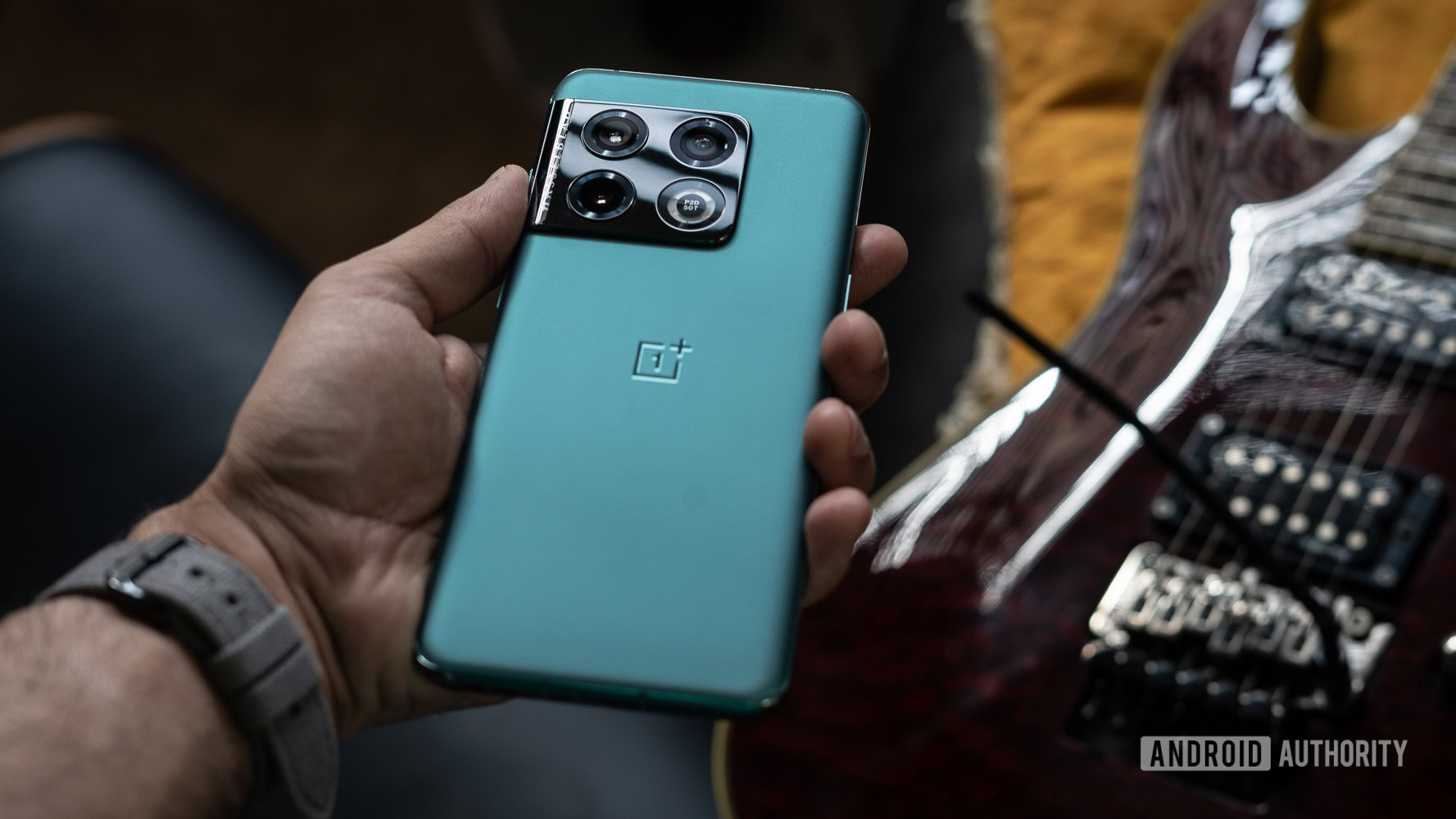
- Gorilla Glass Victus (front), Gorilla Glass 5 (rear), aluminum
- 163 x 73.9 x 8.6mm
- 201g
- In-display fingerprint reader
- T-Mobile exclusive IP68 rating
- Stereo speakers
- Alert slider
- Volcanic Black, Emerald Forest
The OnePlus 10 Pro represents a bold new step for the company, and with it comes a fresh design. Now, it’s not an entirely unique take on hardware design. The phone pays clear homage to the wrap-around camera module we first saw on the Samsung Galaxy S21 Ultra. However, OnePlus has given it its own spin as the module envelopes much of the upper half of the phone’s rear. The end result is a handset that looks distinctive and, for the most part, visually appealing.
The Emerald Forest variant we tested pairs a deep matte green back panel with a glossy black camera finish. The use of ceramic in the camera module is a nice touch, but you’ll have a tough time keeping it free of smudges. I really warmed up to the green shade over my time with the phone. It has a sheen to it that gleams under the right light and gives the phone an air of sophistication. The Volcanic Black (pictured below) has a similarly smooth satin finish, too.
The haphazard branding all over the design is like placing decals on a Lamborghini — don't do it!
Sadly, the assortment of branding all over the back panel really pulls the phone back from reaching the heights of industrial design. The camera module has an enormous Hasselblad logo emblazoned along the edge. The cryptic-sounding “P2D 50T” inscription in the LED flash is equally jarring. Standing for “Phone, 2nd generation Hasselblad camera, and 50MP triple-lens set up,” the nomenclature is completely meaningless and detracts from the visual appeal of the OnePlus 10 Pro.
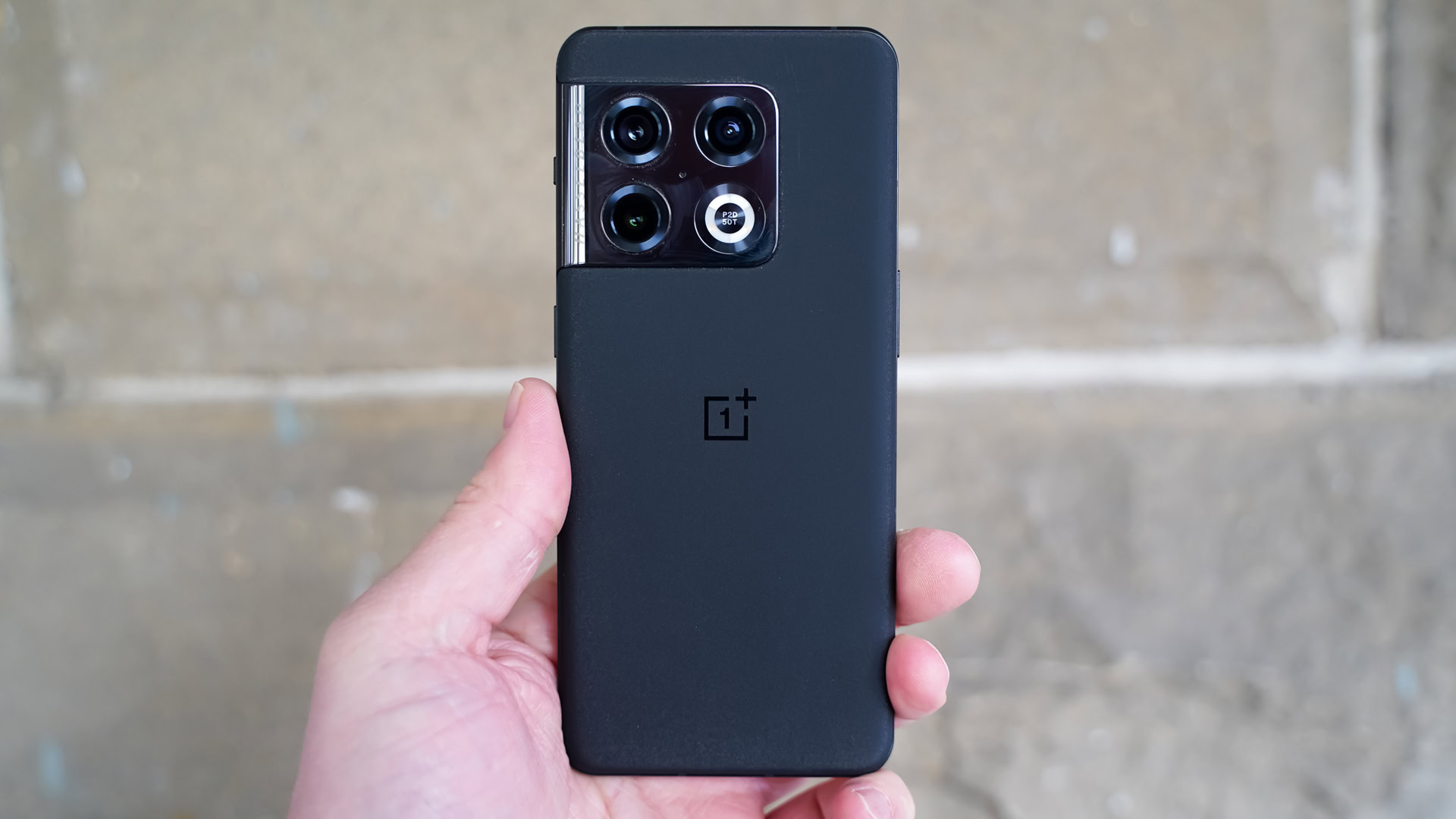
Elsewhere, a matching polished frame (which matches the colorway) runs along the middle of the phone to bind the Gorilla Glass 5 back with the Gorilla Glass Victus front. OnePlus skimped a bit on material costs here as obvious competitors like the Galaxy S22 Plus and Pixel 6 Pro both have Victus glass on both sides.
I’m also not a fan of the finish at the seams of the mid-frame and the glass panels. There’s a very distinct transition between the two elements. Similarly, the volume and power buttons are cut too sharp and I got an unpleasant jab on more than one occasion. It’s a minor nitpick, but you expect better from a phone at this price. It does, however, have an alert slider, which continues to be a welcome signature feature on OnePlus flagships.
The OnePlus 10 Pro looks distinctive, but a lot of questionable concessions were made to hit the price point.
The cost-cutting doesn’t end there. OnePlus has made the bizarre decision to drop an IP rating altogether in all but the T-Mobile variant. The company claims that water resistance and durability testing was done on all variants of the phone, but you’re on your own if you decide to take the phone anywhere near water. This isn’t the first time we’re seeing such a move from OnePlus either, as the OnePlus 9 also only had an IP rating if bought from T-Mobile. The difference here is this is the “Pro” model, and the OnePlus 10 Pro’s previous two direct predecessors both had an IP rating regardless of where you bought it. This is a baffling regression at a time when sub-$500 budget phones have official waterproofing certification.
Elsewhere, the stereo speakers on the OnePlus 10 Pro aren’t particularly impressive. Peak volume levels fall shy of competing phones like the Samsung Galaxy S22 Plus. However, what truly irks me is the unbalanced sound. The distinct difference in volume levels takes away from the immersive experience instead of adding to it. At low volume levels, the speakers sound adequate with an emphasis on treble and little to no bass to speak of. They’ll suffice in a pinch for catching up with a quick YouTube video but I wouldn’t recommend using them for listening to music.
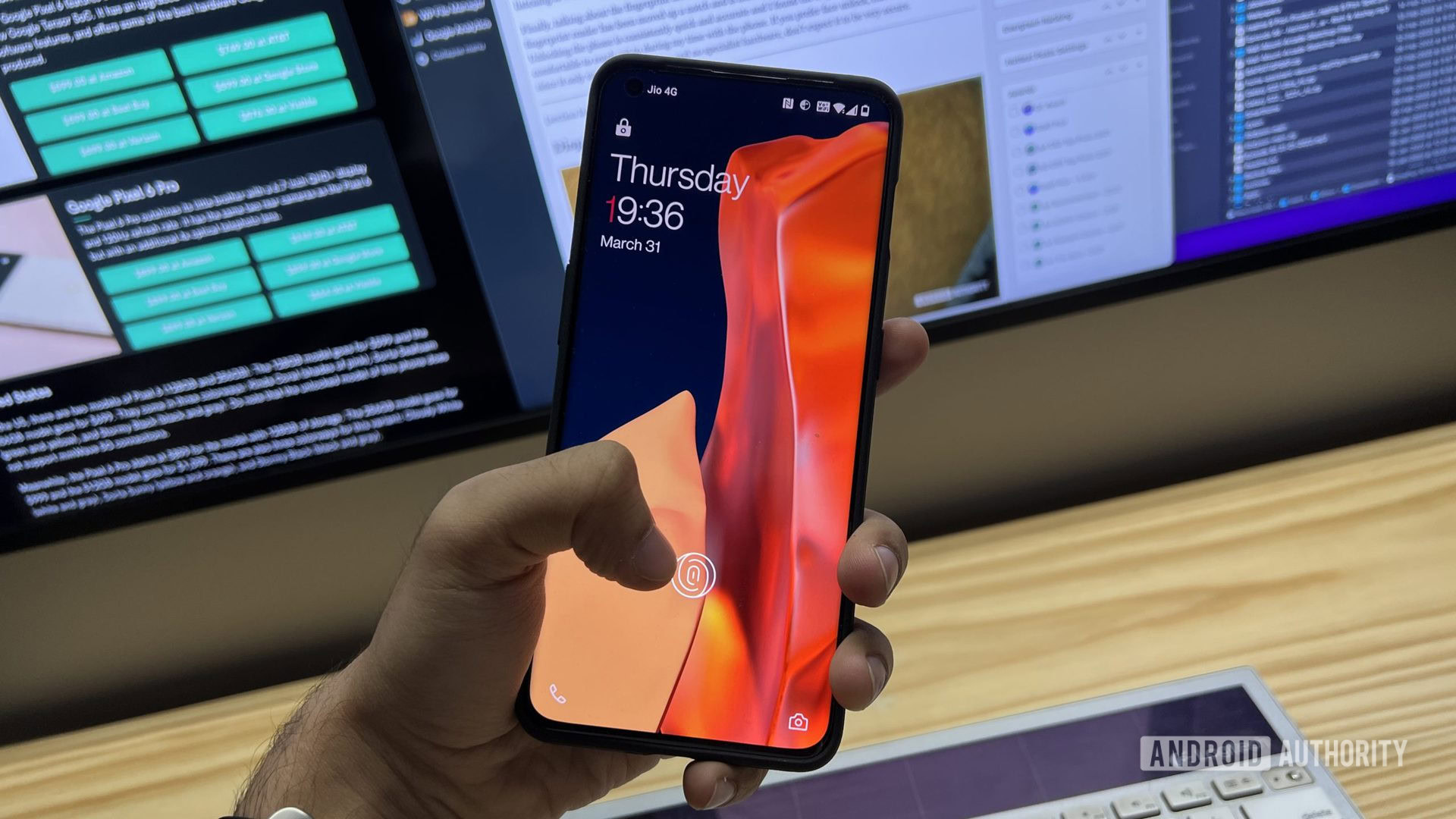
Finally, talking about the fingerprint scanner, OnePlus has clearly listened to feedback. The in-display fingerprint reader has been moved up a notch and is much easier to access compared to its predecessors. Unlocking the phone is consistently quick and accurate and I found the fingerprint reader to be perfectly comfortable to reach out to during my time with the phone. If you prefer face unlock, that’s included too but since it only uses the selfie camera and no specialist hardware, don’t expect it to be very secure.
Display: All-around excellent
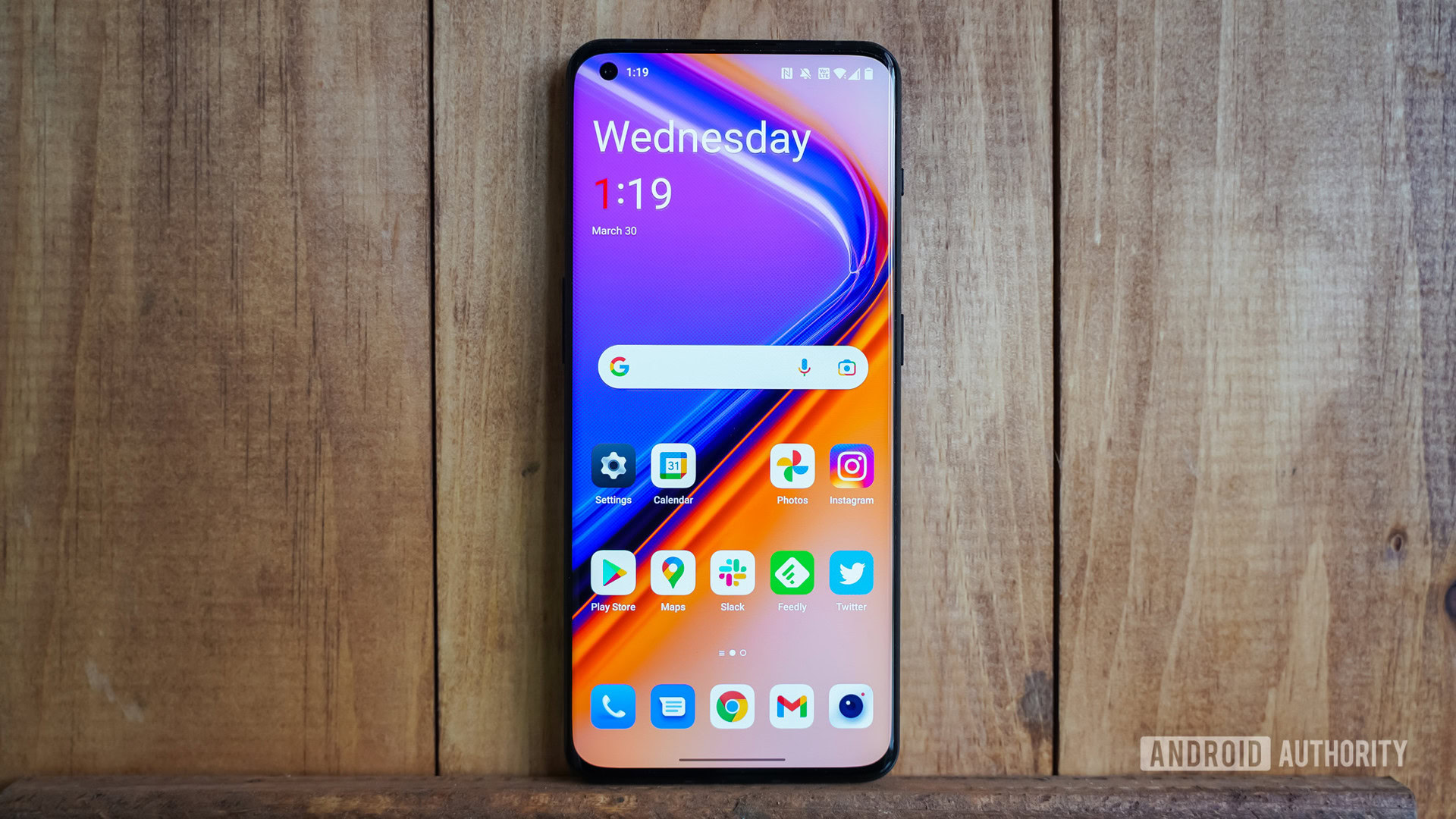
- 6.7-inch AMOLED LTPO
- 3,216 x 1,440
- 525 PPI
- 20:9 aspect ratio, 120Hz refresh rate
The OnePlus 10 Pro doesn’t really move the needle forward when it comes to the display. Thankfully, it didn’t need to do much at all since the OnePlus 9 Pro shipped with a fantastic LTPO panel. The OnePlus 10 Pro retains the same 6.7-inch screen size backed by a familiar QHD resolution and a 20:9 aspect ratio. It’s a comfortable screen size that strikes the perfect balance between ergonomics and offering a large canvas for watching movies, browsing websites, and playing games. The display is set to Full HD+ and 120Hz out of the box but bumping the resolution is just a toggle away if you want to maximize the potential of the screen.
The color calibration of a display can vary quite significantly depending on the brightness levels. To counter that, OnePlus claims that it has calibrated the screen at two commonly used brightness levels — 100 and 500 nits. I can’t say that I noticed much of a difference without digging out my colorimeter. Nevertheless, it’s a fantastic panel that displays accurate-looking colors and offers crisp details, as well as plenty of options in the Settings to tweak things to just how you like.
The OnePlus 10 Pro's 6.7-inch AMOLED panel looks fantastic and gets the job done.
Peak brightness levels go all the way to 1,300 nits which aren’t quite as bright as what Samsung offers on some phones, but that’s just what’s on the spec sheet. In everyday use, watching HDR content on Netflix was incredibly satisfying with a fantastic dynamic range between the deep blacks and searing highlights. No complaints here.
Sunlight during the summers in my home city of New Delhi can be blinding, but the OnePlus 10 Pro held its own and remained adequately visible outdoors. Long-time OnePlus users might be wary about poor automatic brightness control as we’ve seen on some devices from the company. Thankfully, that’s been massively improved. Most days, I felt no need to manually adjust the brightness slider to a more adequate level.
Elsewhere, there’s 120Hz support, of course. Thanks to the LTPO display technology the variable refresh rate can dynamically toggle down to as low as 1Hz to improve battery life. In my testing, the lowest I saw was 10Hz with an instant resync to 120Hz the moment I tapped the screen.
Put simply, the OnePlus 10 Pro display looks and performs fantastically and gets the job done no matter what you’re viewing.
Performance: Capped potential
- Qualcomm Snapdragon 8 Gen 1
- Adreno 730
- 8GB / 12GB RAM
- 128GB / 256GB non-expandable storage
The OnePlus 10 Pro packs the familiar trifecta of modern-day Android flagship internals — a Snapdragon 8 Gen 1 processor paired with 8GB of RAM and 128GB of storage as the base model. 8GB of RAM isn’t the most you can get for this price, but it’ll do the job. There’s also a version with 12GB of RAM and 256GB of storage, which wasn’t available at launch in the US and Canada, but is now available to buy.
The performance of the Snapdragon 8 Gen 1 is a known metric and we’ve already run exhaustive tests on the plethora of options on the market, so performance testing essentially comes down to how OnePlus has tuned the phone.
Like the OnePlus 9 Pro, the OnePlus 10 Pro ships in a downclocked state out of the box. However, unlike last year, the OnePlus 10 Pro comes with a software toggle to unlock high performance right out of the box. I’m not particularly opposed to balancing battery life and performance as long as it doesn’t impede everyday use but, predictably, this can make quite a difference in software benchmarks.
We ran our standard set of benchmarks and the results were intriguing but not surprising. OnePlus appears to have underclocked the hot-running Snapdragon 8 Gen 1 quite aggressively. In fact, CPU-bound benchmarks like Geekbench reported lower scores than last year’s OnePlus 9 Pro. Switching over to the high-performance mode unleashed the full potential of the chipset, and the OnePlus 10 Pro pulled ahead of the similarly equipped Samsung Galaxy S22 Ultra. The gulf between the two modes wasn’t quite as drastic in benchmarks like AnTuTu; in our testing for this OnePlus 10 Pro review, it bested the Samsung Galaxy S22 Ultra in both regular and high-performance modes.
OnePlus appears to have underclocked the hot running Snapdragon 8 Gen 1 quite aggressively, but it performs as you'd hope in everyday use.
Benchmarks are, however, just an indicator of peak performance. I kept the phone on the out-of-the-box, optimized performance profile for my day-to-day use. All through the testing period, the phone chugged along just fine without any errant jitters or slowdowns. In fact, OnePlus has been able to optimize animations just a bit further ever since it made the move to the Color OS codebase, and there’s an extra sense of fluidity to the interface. Multitasking or streaming shouldn’t slow down any modern flagship, and that is the case here.
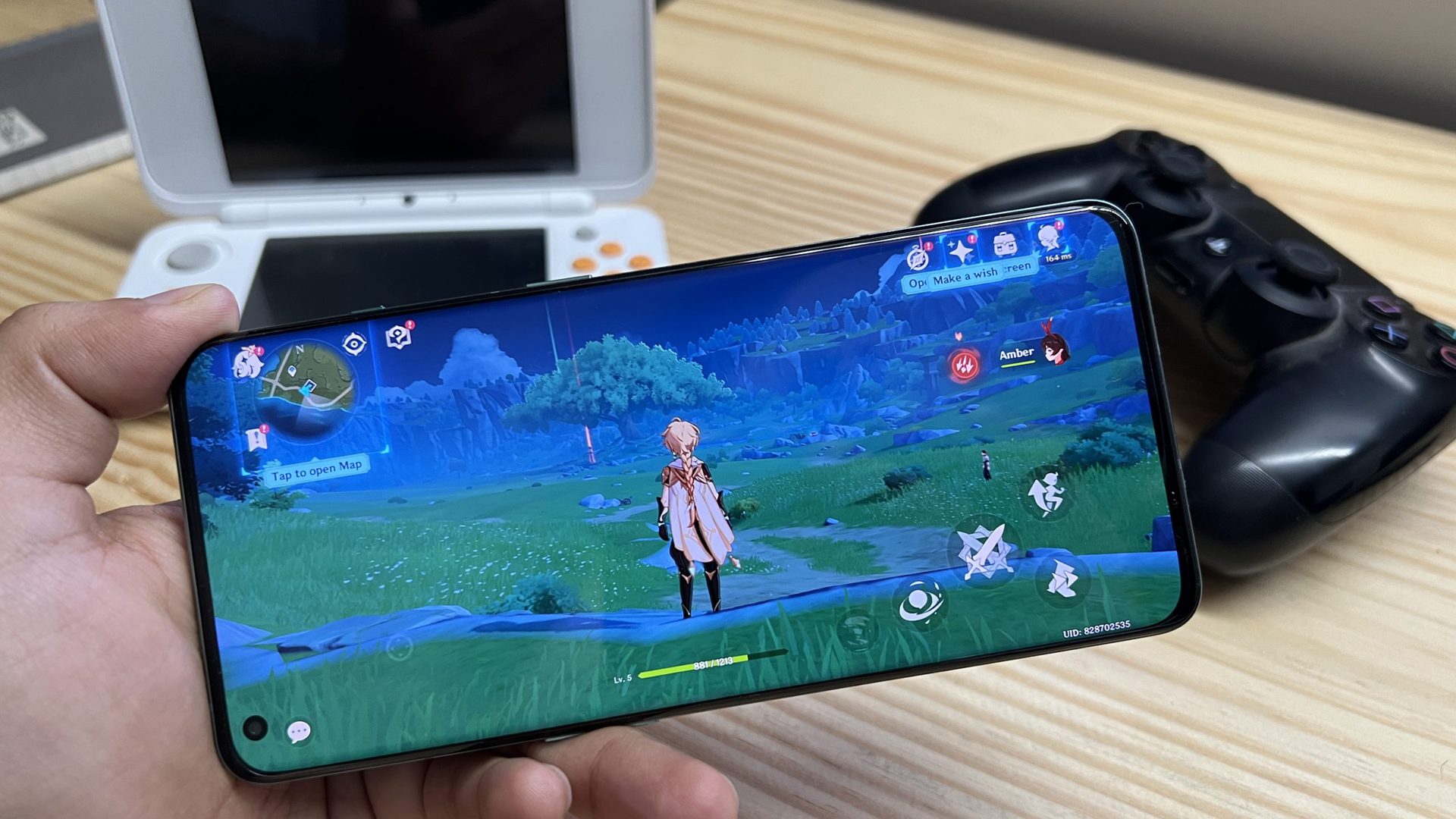
Gaming performance is where things get interesting. The aggressive performance throttling means that demanding titles like Genshin Impact struggle to maintain a smooth 60fps under normal settings. The game jumped anywhere from 40 to 55fps depending on the on-screen action. Switching to high-performance mode gets you much closer to 60fps at the expense of higher battery consumption. Regardless of the mode, OnePlus has done an excellent job at thermal management. The phone rarely crosses 40°C (104°F) during normal use.
Switching over to wireless connectivity, the OnePlus 10 Pro comes with the whole shebang of options that you’d want from a flagship barring mmWave 5G connectivity. That’s a bit of a miss for OnePlus keeping in mind the company’s ambitions for the North American market, especially when the OnePlus 9 Pro supported it for T-Mobile or Verizon users. Moreover, both the Pixel 6 Pro and the Samsung Galaxy S22 Plus include mmWave support at around the same price point. Like the OnePlus 9 Pro, there’s also no support for 5G on AT&T, only LTE.
The lack of mmWave 5G is, however, less of an issue in the company’s dominant territories of Europe and India where sub-6GHz 5G is the norm. I tested out the phone on an LTE network and got a solid network connection throughout the testing period. OnePlus has also done an excellent job with Wi-Fi connectivity and supports Wi-Fi 6 connectivity. Connected to my Wi-Fi 6 mesh network, the phone exhibited none of the wonkiness I’ve observed with the Samsung Galaxy S22 Ultra. While the latter has a tendency to stick to access points despite lower signal strength, the OnePlus 10 Pro roamed between my Ubiquiti mesh network exactly as expected.
The only other omission is the lack of ultra-wideband (UWB) support, a feature that can be found on the equally priced Pixel 6 Pro. While use cases are a little limited at present, it puts the OnePlus 10 Pro at a disadvantage with accessories like Bluetooth trackers or nascent features like unlocking your car using a phone.
Battery: Lasts longer, charges faster
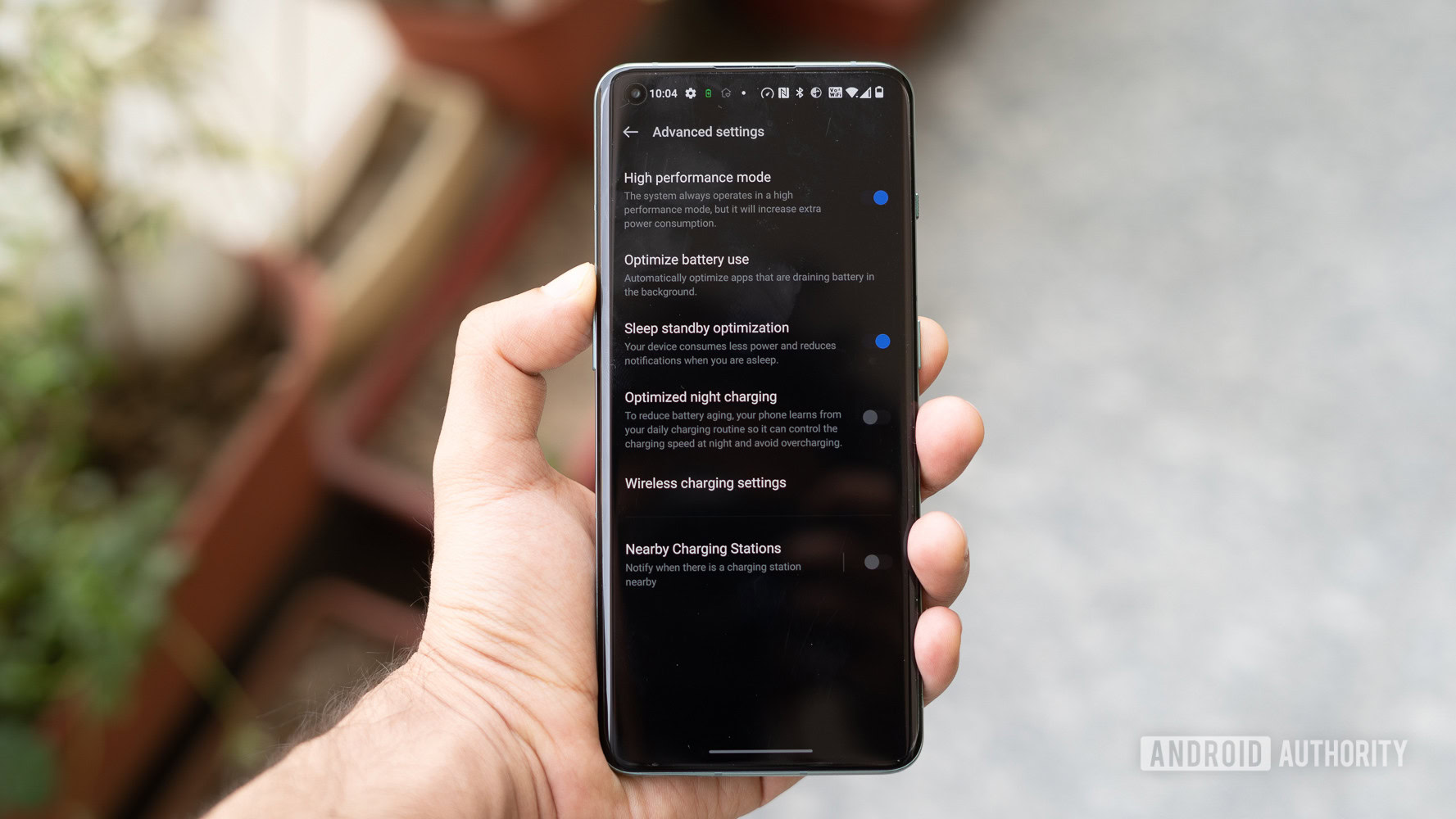
- 5,000mAh
- 80W SuperVOOC wired charging (65W charger in the US)
- 50W AirVOOC wireless charging
- 5W reverse wireless charging
The OnePlus 10 Pro’s leap to a 5,000mAh battery brings it in line with other flagship smartphones. The 500mAh boost over the OnePlus 9 Pro’s cell comes in clutch considering the power-hungry Snapdragon 8 Gen 1 chipset.
Battery life on the phone varies quite a bit but one thing is evident — there’s a very good reason the high-performance mode setting is hidden away under two levels of menus. Keep the mode switched off unless you want to burn through battery life in a matter of hours.
I used the phone with the out-of-the-box settings and the OnePlus 10 Pro could easily last a full day with juice left in the tank. OnePlus hasn’t always been a shining example of battery longevity, so some of the credit may go to the underlying battery optimization magic from the Color OS codebase. Regardless, most users should hit between 6-7 hours of screen-on time depending on usage patterns and you can expect to get a workday out of the phone with ease.
Gone is the Warp Charge branding, and instead you get OPPO’s SuperVOOC tech. It’s really just a matter of branding though since the underlying technology has been the same across the two BBK brands. 80W charging ensures a quick turnaround time for the larger cell, but speeds are not a night and day difference over the 65W charging included with the OnePlus 9 Pro. This is especially the case in the US, where the phone comes with a 65W charger in the box. A OnePlus spokesperson explained to Android Authority that the reason behind the change is due to the charging technology within the charging brick as it, “does not currently support 110 or 120-volt AC power — the typical standard for power outlets in the region.”
The OnePlus 10 Pro's global charging situation is confusing, but all you need to know is it's still absolutely rapid.
Claimed zero to 100% charging times have gone up — keeping in mind the larger battery — and OnePlus says that a full top-up will take 32 minutes. However, that’s under lab conditions. Real-world tests were closer to 36 minutes. My colleague Eric Zeman tested out the US model with its included 65W charger and reported top-off times closer to 34 minutes, though environmental differences will have played a factor in our testing. Regardless, it’s plenty quick in either wattage and far ahead of the rest of the pack in the US. The phone will also top off at 30W speeds using a USB-PD charger as a fallback in case you don’t have the SuperVOOC brick handy.
If, like me, you prefer wireless charging, the OnePlus 10 Pro includes the same rapid wireless charging tech as the OnePlus 9 Pro. Similar to wired charging, the wireless charging solution too has got a rebrand to AirVOOC, however, the underlying tech again remains the same. I clocked about 70 minutes to go from zero to 100% using my older 50W OnePlus Warp 50 charger. Standard Qi charging speeds are much slower at just 15W. Finally, there’s 5W reverse wireless charging support for topping up devices like earphones. It’s not the fastest we’ve seen, but it’ll do the job for topping up accessories.
Camera: A confusing step backwards
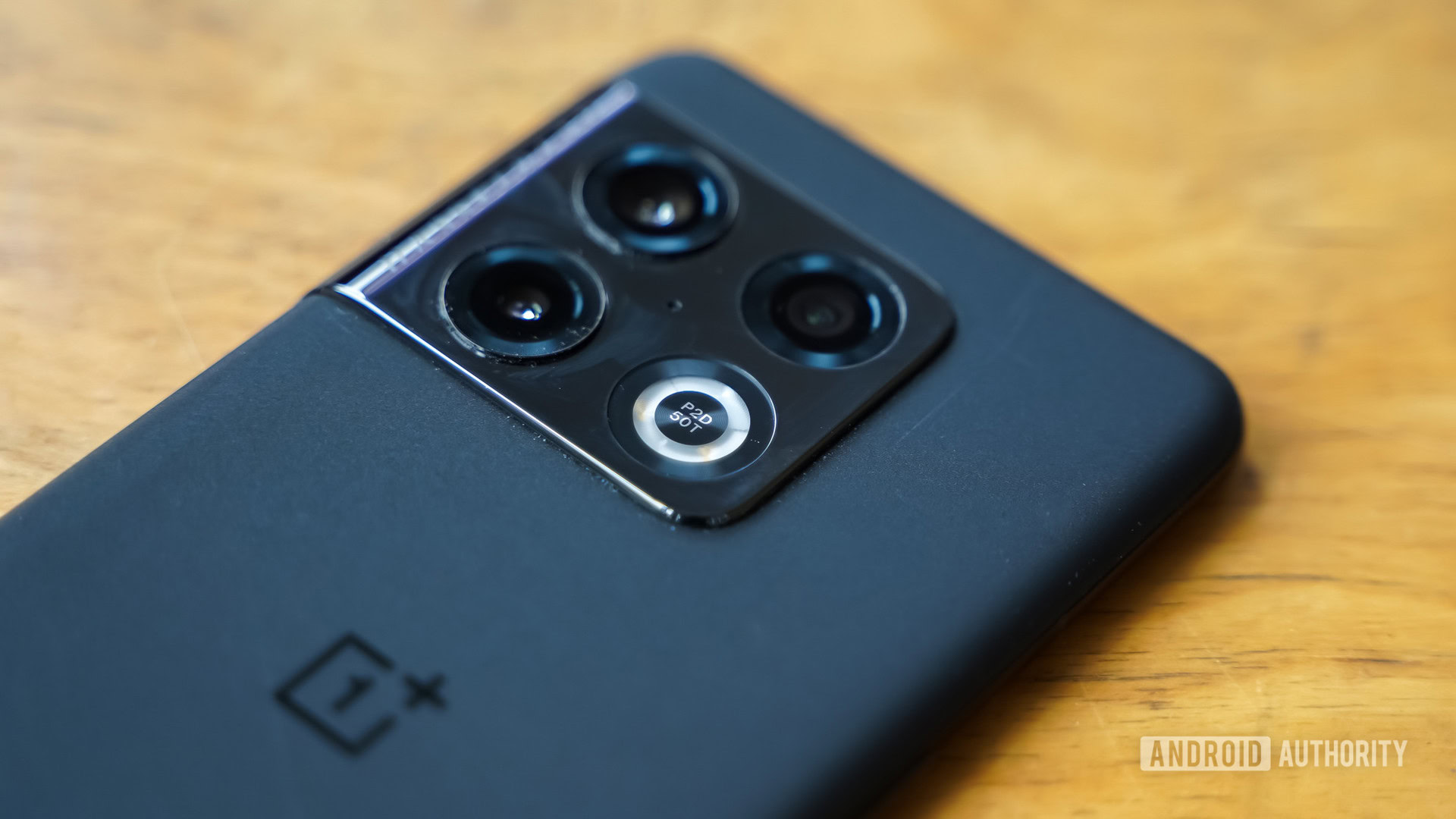
- 48MP, Sony IMX 789, OIS (1/1.43-inch, f/1.8, 1.12µm)
- 50MP ultrawide, Samsung Isocell JN1, (1/2.76-inch, 150-degree FoV)
- 8MP telephoto, 3.3x optical zoom, OIS, (f/2.4)
- 32MP front camera, Sony IMX615, EIS (f/2.2)
- 4K video up to 120fps, 8K up to 24fps
One of our recurring complaints with OnePlus phones over the years has been the lackluster camera optimization at launch. The OnePlus 9 Pro finally made moves towards delivering a consistent camera experience. The OnePlus 10 Pro builds on that legacy by adopting many of the same sensors and optimizations. While that’s a solid foundation, sadly the list of cutbacks is longer than the additions on OnePlus’ latest. Does this result in a more focused approach toward imaging? Let’s find out.
The camera layout is essentially the same with a 48MP IMX 789 sensor paired up with a 3.3x 8MP telephoto lens and a 50MP ultrawide shooter. Interestingly, OnePlus has switched over to an older Samsung JN1 50MP sensor for the ultrawide while increasing the field of view (FoV) to 150-degrees. Meanwhile, the monochrome sensor is gone, and so is autofocus on the ultrawide sensor. The latter means that the camera is flat-out incapable of capturing macro shots. OnePlus isn’t the only company that does this, but it’s a strange choice after offering solid macro photography for several years now.
Images from the primary sensor are generally pleasing. The company’s collaboration with Hasselblad has paid dividends and the color science is relatively true to life. Colors tend to err on the side of punchy, but the exposure and focus are usually spot on. HDR performance has improved by leaps and bounds as can be seen in the shot of the Gorillaz poster above. The camera could comfortably tone down highlights despite very strong sunlight streaming in through the window. That’s not to say all is perfect. The tuning still has a proclivity towards crushing shadows. Additionally, you’ll spot very clear signs of sharpening and noise reduction algorithms once the light starts dipping.
Low-light shots from the OnePlus 10 Pro are, simply put, not very good. The camera struggles with controlling noise and you’ll observe a fine layer of grain throughout the shot. The dedicated Nightscape mode doesn’t help much either. In fact, in several cases, it made the shot worse since it sets the exposure time too long and the built-in OIS is unable to combat camera shake.
As for the ultrawide camera, I’m not too convinced by the company’s decision to opt for a wider frame of view in lieu of a better sensor and autofocus capabilities. The 150-degree FoV suffers from significant distortion around the edges which makes it borderline useless for regular shots. No surprise then that the mode is hidden away under a sub-menu. There’s also a toggle to turn them into circular fisheye shots. Standard ultrawide shots from the OnePlus 10 Pro are instead cropped in from the 50MP sensor with significant distortion correction applied.
The new ultrawide camera with its extreme frame of view is a questionable downgrade.
This is where the limitations of the sensor start to crop up. There’s an inherent softness to the shots despite the heavy-handed sharpening and noise reduction. The camera fares poorly with shadows and any attempts at rescuing detail create a blurry mess of digital noise. These issues are further exacerbated in less than ideal light. In the shot of the desk above, the shadows have been turned into a black void.
Creative users might find some utility for the extreme frame of view, but the lack of auto-focus capabilities and general lackluster quality will be a definite letdown for most everyday users.
OnePlus has been using the same 8MP telephoto sensor on its flagship phones since the OnePlus 8 Pro and it is really starting to show its age. I observed telltale signs of sharpening in nearly every shot I took. This is particularly prevalent in images with a lot of foliage. It can pull off a decent image in perfect conditions, but as you’ll notice in the third shot, purple fringing and noise levels shoot up the moment the sensor is put in a challenging scenario. Moreover, you will want to stay absolutely still as the built-in OIS simply isn’t good enough to combat even a bit of shake.
Portrait mode shots from the OnePlus are generally excellent. The phone does an incredible job at edge detection and had no issues navigating around my unruly mop of hair. OnePlus has also toned down the bokeh effect drastically giving it a much more natural look.
There’s also a fair amount of natural bokeh thanks to the large sensor. The edge detection proved to be nearly flawless time and time again, even when shooting objects, and the resulting portrait mode images were very pleasant to look at.
The 32MP selfie does a decent job, though it occasionally struggled with toning down highlights. Like the rear camera, the edge detection algorithms do a pretty decent job though I observed that the front camera would often trip along the boundaries of my hair. It’s good, but not perfect.
Video recording on the OnePlus 10 Pro goes all the way to 8K at 24fps, but I found the sweet spot to be 4K 120fps. The camera applies a very significant crop in both 60 and 30fps mode. Footage shot in 4K looks great with crisp details and natural-looking colors.
The list of cutbacks on the camera setup is longer than the additions on the OnePlus 10 Pro.
As for the Camera app, it’s been lifted straight from Color OS. That’s not necessarily a bad thing, but as I mentioned before, features like the much-touted 150-degree camera view are tucked far away under additional settings. It’s not bad, but it sure comes across as clunky.
You can check out the full-resolution camera samples in this Google Drive folder.
Software: More OPPO than OnePlus
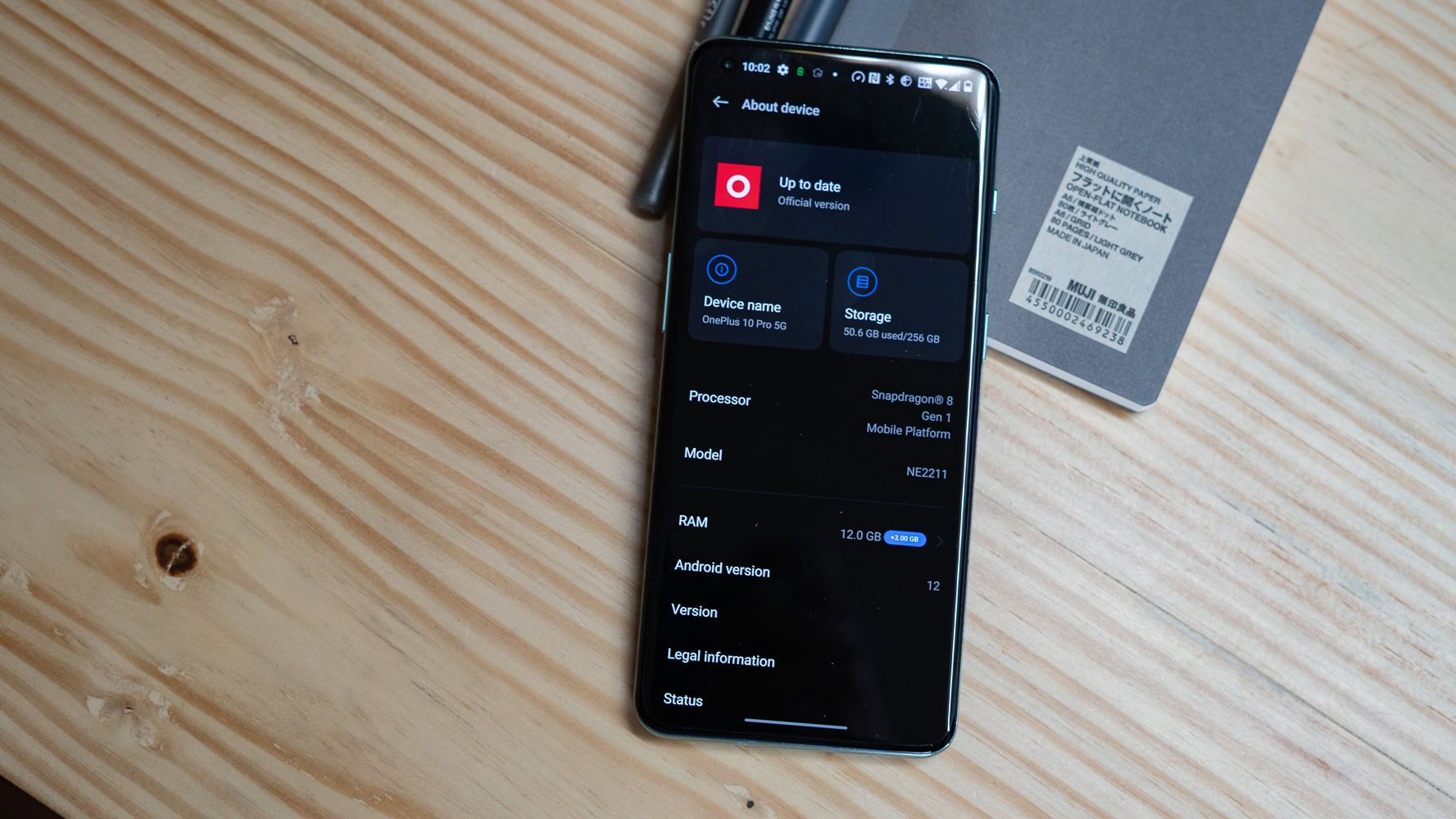
- Android 12
- Oxygen OS 12.1
- Three years OS updates, four years security updates
To say that it’s been a rough year for Oxygen OS would be putting it mildly. OnePlus’ reputation was built around its near-stock take on Android and the initial decision to merge it with Color OS was met with significant backlash from the community. OnePlus then announced that it plans to keep Oxygen distinct from Color OS despite sharing the same underlying code. We won’t see the full effect of the transition until Oxygen OS 13, however. Instead, the OnePlus 10 Pro ships with the Android 12-based Oxygen OS 12.1.
The entire operating system reeks of different ideologies and multiple teams trying to cobble together a solution. To take one small example, there’s a very obvious discrepancy in font size between the Gallery app and the rest of the interface. Long-standing bugs like missing notifications are still a problem too. You simply can’t count on the phone to notify you of incoming emails or messages on a consistent basis.
Oxygen OS on the OnePlus 10 Pro feels like a facsimile copy of the Android skin everyone came to love.
Pulling down from the right of the notification panel reveals the OnePlus Shelf which can now be customized with widgets and feature cards. Users can move these widgets around to create a layout that works best for them. The shelf also integrates OnePlus Scout for quick on-device search. Both features work well enough, and we’ve seen them before on OnePlus devices. However, it is the implementation that spells Color OS more than Oxygen OS. Thankfully, OnePlus makes it easy enough to get rid of the pull-down drawer.
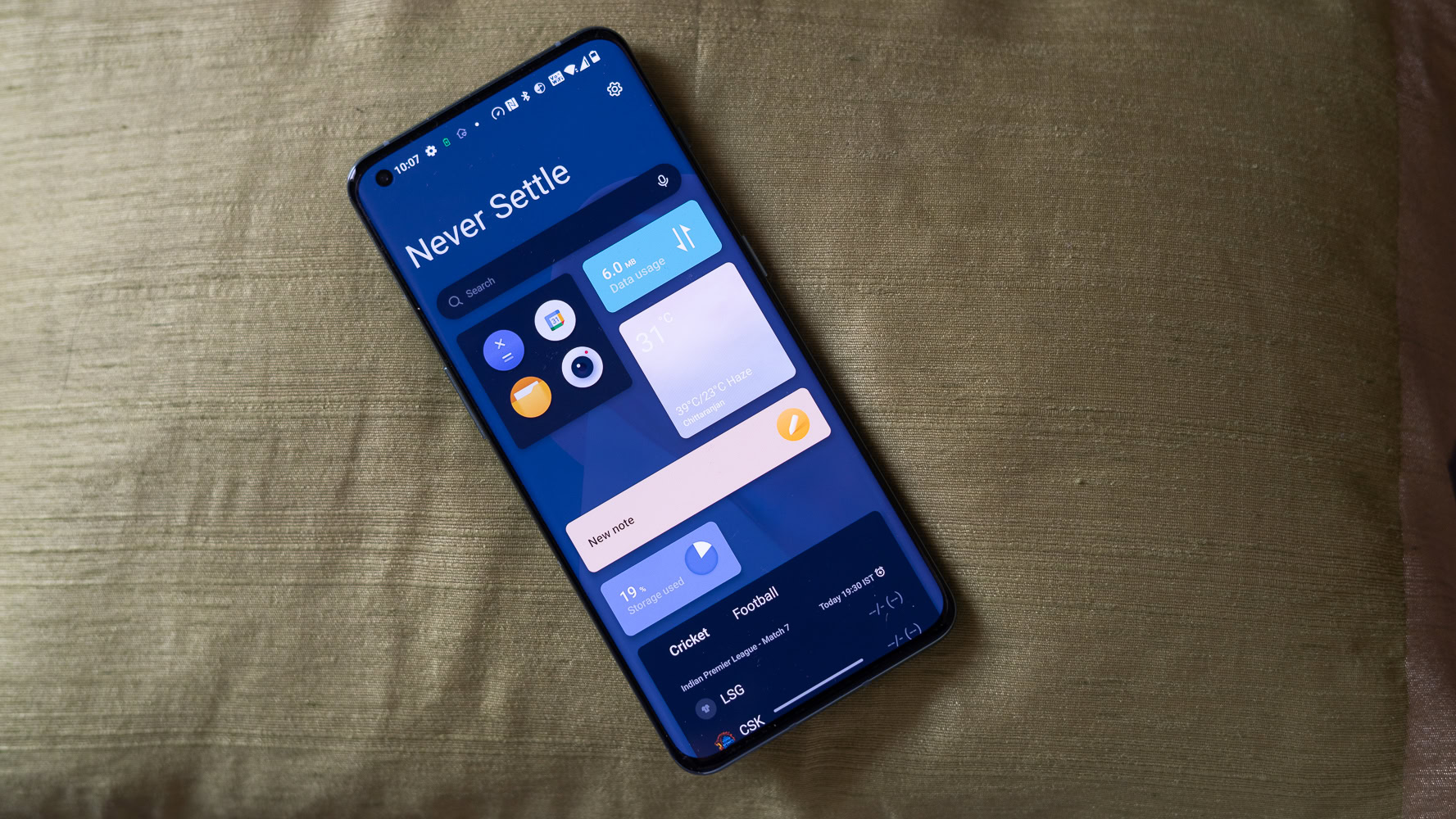
Other features include a revamped Work-Life Balance mode to maintain separate whitelists and profiles depending on the time of day. I went in a bit skeptical, but the feature works exceptionally well to cut out errant notification spam from apps. Oxygen OS 12.1 also brings back granular control over dark mode settings. You’ll find three options that go from a light grey interface, all the way through black. It won’t please dark mode purists though as the notification hub continues to sport a grey hue.
OnePlus is also touting a new Private Safe feature. We’ve seen this before within the Gallery app and the concept here is similar. The private safe function isolates your photos, videos, and documents into a password-protected lockbox. However, the implementation is a bit lacking since you can only use the default Gallery and File apps to move files into the lockbox.
Thankfully, there’s no bloatware still and the only preloaded apps you’ll spot are those for Spotify and Netflix, though both can be uninstalled.
Overall, the impression you get after spending some time with the phone is that the switch to the Color OS codebase sucked the soul out of Oxygen OS. Color OS on its own merit is pretty great, but this is a half-step between it and Oxygen OS that’s rough around the edges. There’s speed and fluidity to be found here, no doubt, but Oxygen OS on the OnePlus 10 Pro feels like a facsimile copy of the Android skin everyone came to love.
Regardless, the company is promising three major OS updates which should give you plenty of time to witness the evolution of Oxygen OS. Additionally, buyers can expect four years of security patches. This isn’t quite on the level of Google or especially Samsung, but it’s a fair software guarantee for a flagship Android phone.
OnePlus 10 Pro specs
| OnePlus 10 Pro | |
|---|---|
Display | 6.7-inch LTPO AMOLED 120Hz variable refresh rate QHD+ (1440p) resolution |
Processor | Snapdragon 8 Gen 1 |
RAM | Up to 12GB LPDDR5 |
Storage | Up to 256GB UFS 3.1 No microSD card slot |
Power | 5,000mAh battery 80W wired charging 50W wireless charging (with proprietary stand) 5W reverse wireless charging 65W charging brick in box in US (80W in other markets) |
Cameras | Rear - 48MP wide - 50MP ultrawide, up to 150-degree FoV - 8MP telephoto 10-bit color capture on all lenses 12-bit RAW capture on all lenses Dual OIS on at least one lens Second-gen Hasselblad software Front: - 32MP |
Audio | Dual stereo speakers No 3.5mm headphone port |
Connectivity | Bluetooth 5.2 NFC support 5G support |
Dimensions | 163 x 73.9 x 8.55mm |
Software | Oxygen OS 12 based on Android 12 China only: Color OS 12 based on Android 12 |
Colors | Volcanic Black, Emerald Forest |
Value and competition

Falling close to $1,000 at launch, the OnePlus 10 Pro is cheaper than its predecessor but still a far cry from its aggressively priced flagship killers of yore. Barring ultra-premium devices like foldables or the Samsung Galaxy S23 Ultra, the OnePlus 10 Pro truly is a flagship as far as prices go. But for all that money spent, the OnePlus 10 Pro comes across as a case of one step forward, and a few steps back. Now, the permanent price drop to $799 makes the phone a far better value, but it’s still not a great smartphone deal due to some questionable choices. The faster chipset and improved design are all well and good, but those are table stakes in the category. What matters are the little things like fit and finish, consistency in software, and OnePlus’ Achilles’ heel — imaging.
Perhaps the biggest competitor for the OnePlus 10 Pro comes from within the company’s own stable. The newer OnePlus 11 ($1296 at Amazon) is effectively the direct successor of the OnePlus 10 Pro. We get an upgraded Snapdragon 8 Gen 2 chipset, a new circular camera array, and bonkers charging speeds. However, the phone still exhibits the usual OnePlus failings, from middling camera performance to the lack of wireless charging. It’s much cheaper than the OnePlus 10 Pro at full price, so it’s well worth considering.
Stepping back a generation, 2021’s OnePlus 9 Pro ($755 at Amazon) might not have as futuristic a design, but it offers a very similar performance envelope, very similar battery life, an IP rating, and, arguably, a better camera set up for a lower price. The value flagship segment is, well, all about value, and if it is a OnePlus that you seek, the OnePlus 9 Pro gets you most of the way there for less as it can be found for much cheaper on sale.
Then there’s also the OnePlus 10T ($451.71 at Amazon). It offers less overall, sporting a lower-res display, weaker cameras, and a smaller battery. But it does have a cheaper price tag, a newer Snapdragon 8 Plus Gen 1 chipset, and faster charging.
Samsung’s Galaxy S23 ($799 at Amazon) and Galaxy S23 Plus ($999.99 at Samsung) are arguably the Android benchmarks right now. Both phones have the same internal setup and a design that looks and feels absolutely premium. It’s hard to look past Samsung’s excellent camera setup on the Galaxy S23 series, too that produce admirable images in most scenarios. The support for mmWave 5G might also be something to consider, and you, of course, get an IP rating as standard. From a value standpoint, the four years of software support (plus five years of security patches) and better resale value make the Samsung duo hard to beat. In that same vein, the previous Galaxy generation is still well worth considering.
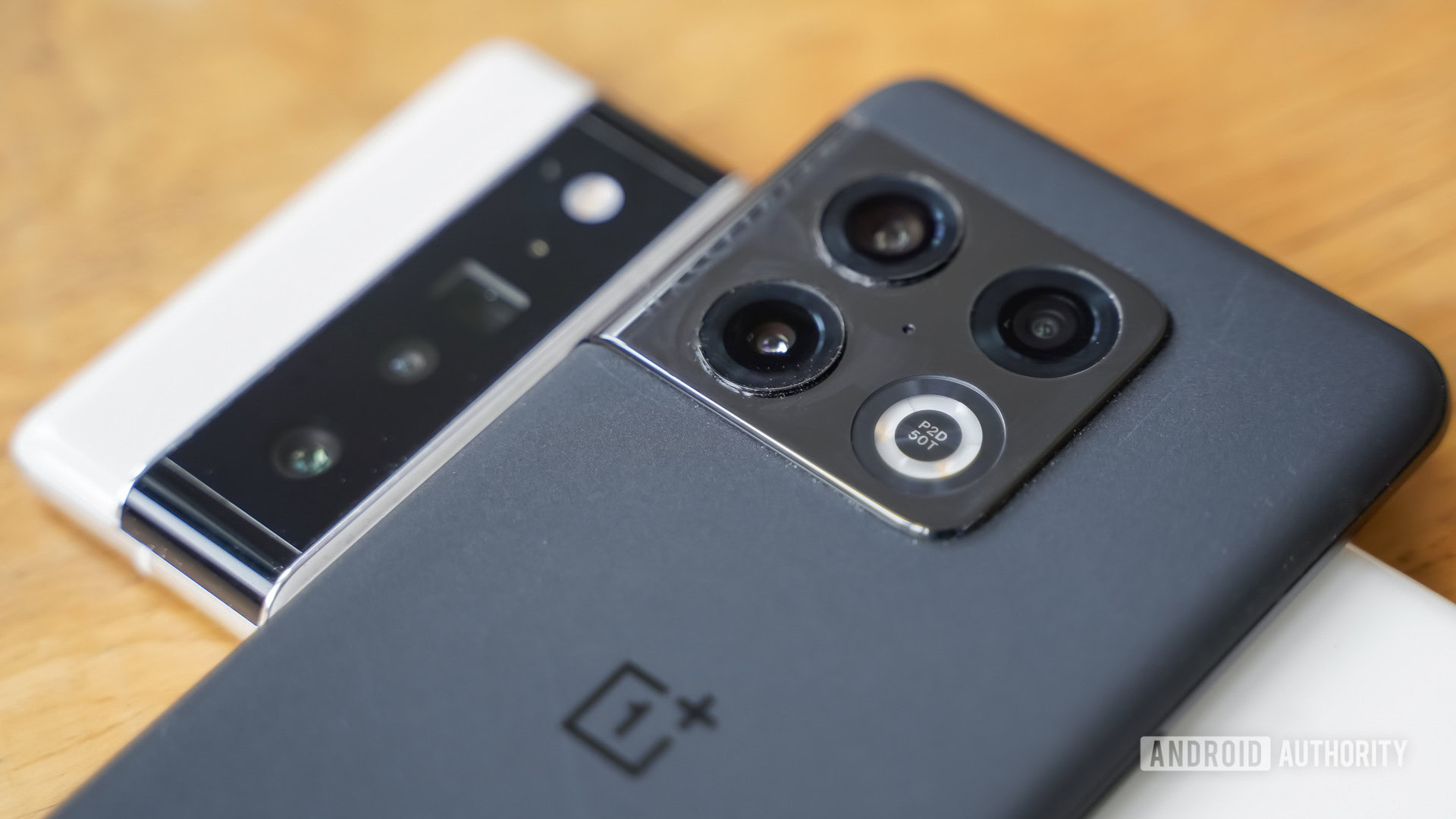
It’s impossible to ignore the Pixel 7 Pro ($530 at Amazon) as well. Google’s flagship smartphone is the very definition of a well-balanced flagship that now costs a bit more than the OnePlus 10 Pro. The Tensor chipset eschews all-out performance for all-day reliability and the design might not be everyone’s cup of tea, but it sure is unique. However, it’s the standout imaging capability that makes it an easy sell to budding smartphone photography enthusiasts. Meanwhile, the Pixel 7 ($359.99 at Woot!) gets you most of the way there for a ridiculously affordable price. The only caveat? You’ll have to miss out on the telephoto lens.
And then there’s the elephant in the room — the Apple iPhone 14 ($604 at Amazon). The phone’s A15 Bionic chipset, while not the latest, is far ahead of the Snapdragon-powered competition all while balancing frugal battery consumption. The world-class app and gaming ecosystem is bound to appeal to performance seekers too. The phone holds its own in the imaging department as well though the missing telephoto lens might be a bummer to some. Similarly, it is hard to ignore the sheer value offered by the iPhone 14 Pro ($799.99 at Amazon). For an additional $200, it nets you a very good telephoto sensor, a faster A16 Bionic SoC as well as one of the most well-built smartphones around. iOS won’t be for everyone, but it’s hard to deny Apple’s incredible software support.
OnePlus 10 Pro review: The verdict
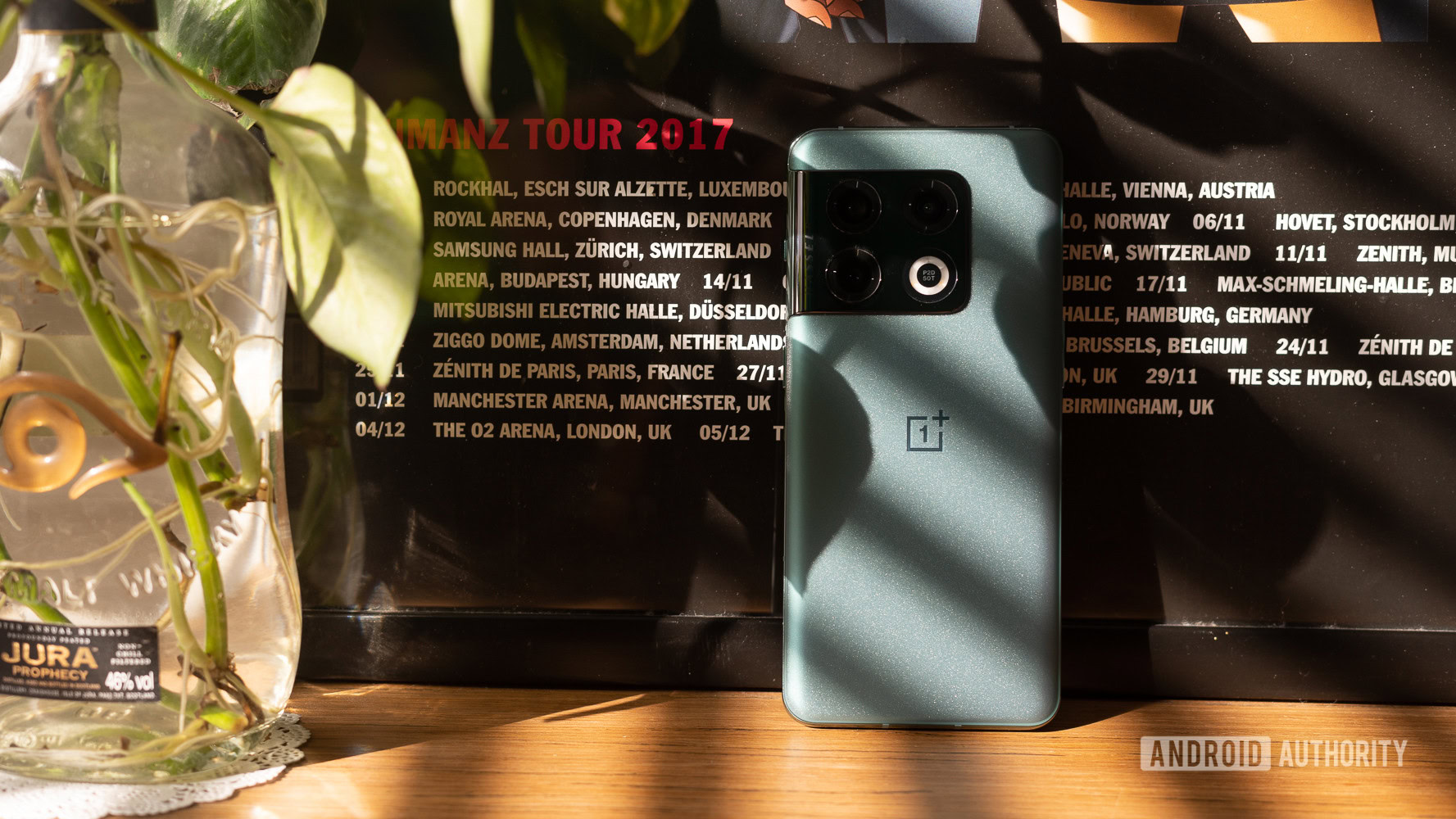
Testing the OnePlus 10 Pro made it clear to me that the phone is a product of an OPPO-ified OnePlus — and that’s not necessarily a bad thing. The backing of BBK’s favorite child has facilitated more consistent imaging, better battery life, fewer bugs, and a generally pleasant user experience. It’s also got some high highs in the gorgeous display and one-two punch of super-fast charging and improved battery life.
Unfortunately, the merger has resulted in a phone that’s generic. The software lacks that once signature OnePlus personality and the lack of attention to detail across the entire package is telling. The steps back taken by the camera, the lack of an IP rating for the unlocked model, the imbalanced speakers, and missing flagship extras like mmWave 5G emphasize that the days of never settling are gone.
The OnePlus 10 Pro is representative of a new era at OnePlus, for better and for worse.
The OnePlus 10 Pro is representative of a new era at OnePlus. One where the goal is to maximize profitability with good enough phones that can ship larger numbers. The OnePlus 10 Pro doesn’t excite but does what it promises on the box to an adequate level, which is exactly what it takes to up the bottom line, but certainly not to build a fan following.
We were beginning to see a more gutsy OnePlus after the release of the OnePlus 9 Pro, a company that was raring to go against the best of the best with no compromises. The OnePlus 10 Pro isn’t that phone. It’s a safe bet that takes no risks towards pushing any boundaries. In fact, it does the exact opposite by omitting existing features. It’s an odd play at a time when the rest of the competition is bending over backward to offer more to customers. The $100 price cut breathes some new life into the device, but it’s also met with new competition in the OnePlus 10T, and even stronger rivals from Samsung, Apple, and especially Google with the Pixel 7.
The OnePlus 10 Pro might not thrill long-time fans but is aimed at bringing a newer, more mainstream audience into the fold. Unfortunately, along the way, it also reinforces the fact that the old OnePlus is well and truly dead.
OnePlus 10 Pro top questions and answers
No, the OnePlus 10 Pro does not have an SD card slot, which means you have to think carefully about which storage variant to get (you can choose between 128GB and 256GB).
Only the T-Mobile variant of the OnePlus 10 Pro is IP68 rated, meaning it will survive in up to 1.5m of water for up to 30 minutes. This means that devices sold by OnePlus, Amazon, and other retailers don’t have an official IP rating.
While this storage variant wasn’t available in the US at launch, OnePlus did start selling it starting June 15.
Yes, you’ll find OnePlus’ signature Alert Slider on the right side of the handset.
Yes, the OnePlus 10 Pro features an always-on display.
You can get the phone in two colors: Volcanic Black and Emerald Forest.
Yes, it does. However, US consumers get a 65W charger in the box, while those from other countries get an 80W charger.
Yes, the OnePlus 10 Pro supports sub-6GHz 5G, but it does not support mmWave technology. Additionally, the phone doesn’t work on AT&T’s 5G network.
Yes, the OnePlus 10 Pro works on Verizon, including its C-Band network.